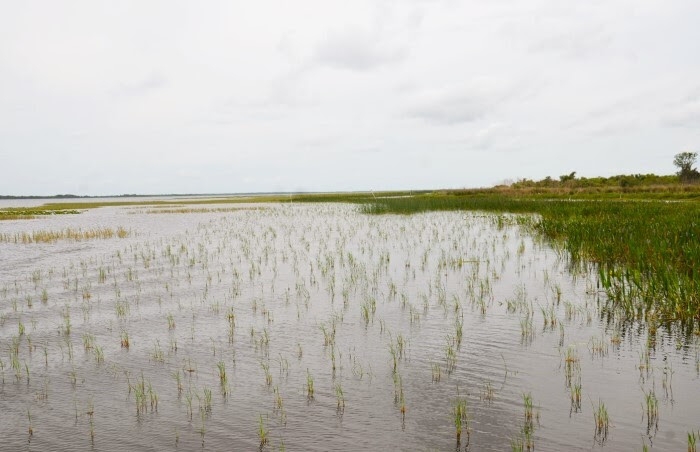Large-scale planting project completed at Lk. Kissimmee
Florida Fish and Wildlife Conservation Commission (FWC)
The Florida Fish and Wildlife Conservation Commission (FWC) recently completed a large-scale aquatic habitat restoration effort on Lake Kissimmee, planting nearly 325,000 native aquatic plants to promote expansion of a healthy habitat for fish and wildlife.
The 34,948-acre Lake Kissimmee is located 40 miles south of Orlando in Osceola and Polk counties. It's a popular location for anglers targeting largemouth bass, bluegill, redear sunfish and black crappie. The lake is also a historical hunting lake and wildlife viewing destination. Lake Kissimmee is home to several threatened and endangered species, including the Everglade snail kite.
In recent years, Lake Kissimmee’s aquatic grass and bulrush beds have been in decline, due to hurricanes, artificially stabilized water levels, and grazing by exotic apple snails. Ths restoration project will enhance and stimulate growth of these historically important grasses for the benefit of fish, wildlife, anglers, hunters and wildlife viewers.
In the northern, western and eastern shorelines of Lake Kissimmee, at a cost of $500,000, Ihe FWC successfully planted 180,000 maidencane and 68,000 paspalidium - both grass species commonly known as "Kissimmee grass" - and over 76,000 bulrush plants. Plantings were concentrated around local landmarks known to anglers and other recreational boaters on the lake, including North Cove, Lemon Point, the School Bus area and Jack’s Slough.
The bulrush and native grasses were planted in 2 to 3 feet of water during naturally low water levels (on average, 50-feet National Geodetic Vertical Datum, or NGVD). The planted areas will be in 5 to 6 feet of water during high pool stage. This deeper fish and wildlife habitat will provide additional angling and wildlife viewing opportunities, as well as provide perching, nesting and foraging habitat for the Everglade snail kite.
This work aligns with the FWC Kissimmee Chain of Lakes Fish, Wildlife, and Habitat Management Plan, which was developed with input from a combination of stakeholders. One of the objectives in this plan is to increase native submersed and emergent aquatic vegetation through revegetation efforts, to compete with and reduce coverage of invasive plant species.
For more information about this project, contact Adriene Landrum with the FWC’s Aquatic Habitat Conservation and Restoration Section at 407-846-5269. For general waterbody information, fishing forecasts, virtual tours, plant control operation schedules and annual workplans, boat ramp information, and more, visit the “What’s Happening on My Lake” website at MyFWC.com/lakes.
Top
The Florida Fish and Wildlife Conservation Commission (FWC) recently completed a large-scale aquatic habitat restoration effort on Lake Kissimmee, planting nearly 325,000 native aquatic plants to promote expansion of a healthy habitat for fish and wildlife.
The 34,948-acre Lake Kissimmee is located 40 miles south of Orlando in Osceola and Polk counties. It's a popular location for anglers targeting largemouth bass, bluegill, redear sunfish and black crappie. The lake is also a historical hunting lake and wildlife viewing destination. Lake Kissimmee is home to several threatened and endangered species, including the Everglade snail kite.
In recent years, Lake Kissimmee’s aquatic grass and bulrush beds have been in decline, due to hurricanes, artificially stabilized water levels, and grazing by exotic apple snails. Ths restoration project will enhance and stimulate growth of these historically important grasses for the benefit of fish, wildlife, anglers, hunters and wildlife viewers.
In the northern, western and eastern shorelines of Lake Kissimmee, at a cost of $500,000, Ihe FWC successfully planted 180,000 maidencane and 68,000 paspalidium - both grass species commonly known as "Kissimmee grass" - and over 76,000 bulrush plants. Plantings were concentrated around local landmarks known to anglers and other recreational boaters on the lake, including North Cove, Lemon Point, the School Bus area and Jack’s Slough.
The bulrush and native grasses were planted in 2 to 3 feet of water during naturally low water levels (on average, 50-feet National Geodetic Vertical Datum, or NGVD). The planted areas will be in 5 to 6 feet of water during high pool stage. This deeper fish and wildlife habitat will provide additional angling and wildlife viewing opportunities, as well as provide perching, nesting and foraging habitat for the Everglade snail kite.
This work aligns with the FWC Kissimmee Chain of Lakes Fish, Wildlife, and Habitat Management Plan, which was developed with input from a combination of stakeholders. One of the objectives in this plan is to increase native submersed and emergent aquatic vegetation through revegetation efforts, to compete with and reduce coverage of invasive plant species.
For more information about this project, contact Adriene Landrum with the FWC’s Aquatic Habitat Conservation and Restoration Section at 407-846-5269. For general waterbody information, fishing forecasts, virtual tours, plant control operation schedules and annual workplans, boat ramp information, and more, visit the “What’s Happening on My Lake” website at MyFWC.com/lakes.
